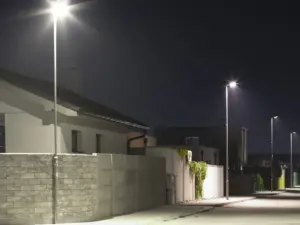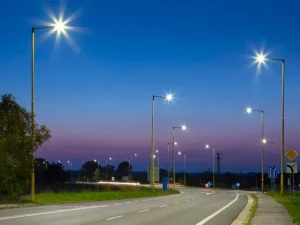Pendahuluan:
The history of street lighting dates back to ancient times. Over the centuries, technological advancements have led to the development of various lighting sources. And each of them has its own set of advantages and drawbacks. How many watts does a street light use? Several factors influence the wattage of streetlights. This article will give you the answer.
Types of Street Lights
Incandescent Lights
In the early 20th century, incandescent lights became a common choice for street lighting. These lights work by heating a filament until it emits light. However, they are known for their inefficiency. With them, a significant portion of the energy is lost as heat rather than light. As a result, they typically consume more watts to produce the necessary illumination.
High-Pressure Sodium (HPS) Lights
High-Pressure Sodium (HPS) lights gained popularity in the mid-20th century. This is due to their improved efficiency compared to incandescent lights. HPS lights emit light by passing an electric current through a mixture of gases and sodium vapor. This produces a characteristic yellow-orange glow. They are more energy-efficient than incandescent lights. However, they still require a considerable amount of wattage to achieve sufficient brightness.
Light-Emitting Diode (LED) Lights
In recent years, Light-Emitting Diode (LED) technology has revolutionized street lighting. LED lights are highly energy-efficient. They produce more light per watt compared to traditional options. They are also known for their longevity and durability. As a result, many municipalities and cities have been transitioning to LED street lights. This is to reduce energy consumption and maintenance costs even if peak hours are longer.
Factors Influencing Street Light Wattage

Several factors influence the wattage of streetlights. They play an important role in deciding how many watts does a street light use. So, municipalities must carefully consider these variables when selecting lighting options. This is not only good for them but for their communities as well.
Road Type and Size
The size and type of road play a crucial role in determining how many watts is a street light. Larger roads and highways typically require higher wattage. This is to ensure adequate illumination over a greater distance. In contrast, smaller residential streets may need less powerful lights.
Light Distribution
The design and distribution also impact the overall wattage needed. Efficient light distribution ensures that illumination is directed where it is needed most. Thus, minimizing wasted energy and reducing the required wattage.
Lighting Standards and Regulations
Municipalities often follow lighting standards and regulations set by governing bodies. These standards provide guidelines on the appropriate level of illumination. These can vary for different types of roads and public spaces. Adhering to these standards helps ensure that streetlights meet the necessary safety and visibility requirements.
Technological Advancements
As technology continues to advance, street light manufacturers are developing more energy-efficient solutions. LED technology, in particular, has undergone significant improvements lately. It is now allowing for higher lumen output with lower wattage consumption. Municipalities looking to upgrade their street lighting infrastructure can benefit from these advancements. This will reduce energy costs and negative environmental impact.
Calculating Street Light Wattage
The appropriate wattage for streetlights involves considering the desired level of illumination. And the specific characteristics of the area being lit. The following steps provide a basic guide for calculating how many watts does a street light use:
Determine Required Luminance
Luminance is the amount of light emitted per unit area. Different areas, such as roads, sidewalks, and parking lots, may require different levels of luminance. Consulting lighting standards can help determine the recommended luminance levels for specific applications. It will answer the question of how many watts are street lights.
Consider Light Distribution
The design of the light fixture provides the amount of wattage needed. Efficient fixtures ensure that light is directed where it is needed. This minimizes waste and reduces the overall wattage requirement.
Evaluate Road Characteristics
Road size and traffic volume influence the required wattage. Larger roads with higher traffic may require more powerful lights for adequate illumination.
Explore Technological Options
Consider the latest lighting technologies, such as LED, which offer higher efficiency. They have lower wattage consumption compared to traditional options.
By carefully considering these factors, municipalities can make informed decisions. They will understand appropriately how many watts does a street light use consumes. It will help them balance the need for visibility and safety with energy efficiency.
Energy Efficiency Initiatives
With a growing emphasis on sustainability, many cities are implementing energy efficiency initiatives. This is to reduce the environmental impact of street lighting. LED technology, in particular, has played a significant role in these efforts.
LED Retrofitting
Enhancing energy efficiency by retrofitting existing light fixtures with LED bulbs is easy. This allows municipalities to take advantage of the benefits of LED technology. This is without the need for a complete infrastructure overhaul. LED retrofitting can result in significant energy savings. It also reduces maintenance costs over time.
Smart Lighting Systems

Smart lighting systems leverage advanced technologies. Examples are sensors and automation, which optimize energy use. These systems can adjust brightness based on real-time factors, such as traffic density or ambient light. By adapting to changing conditions, smart lighting systems ensure that energy is used efficiently. This is while maintaining adequate illumination.
Collaborative Efforts
Cities and municipalities are increasingly collaborating with technology providers. It involves energy experts to develop customized solutions for their street lighting needs. These collaborations focus on how many watts are street lights are being deployed. It also helps in implementing best practices to create sustainable and energy-efficient systems.
FAQs for How Many Watts Does A Street Light Use?
What factors determine the wattage of streetlights?
Various factors influence the wattage of streetlights. They include the type and size of the road. It also depends on the desired level of illumination and light distribution characteristics. Adherence to lighting standards and advancements in lighting should also be considered.
How does LED technology contribute to energy efficiency in street lighting?
LED technology is highly energy-efficient. It produces more light per watt compared to traditional options like incandescent or HPS. LED lights also have a longer lifespan and lower maintenance requirements. This makes them a sustainable choice for street lighting.
Can existing streetlights be upgraded to improve energy efficiency?
Yes, one common approach is retrofitting existing street light fixtures with LED bulbs. This allows municipalities to benefit from the energy efficiency of LED technology. And this is without the need for a complete infrastructure overhaul. It results in significant energy savings and reduced maintenance costs.
Kesimpulan:
The question of how many watts a street light uses is multifaceted. Factors such as road type, light distribution, etc., all play a crucial role. As we continue to prioritize energy efficiency and sustainability, equations change. The evolution of street lighting technologies, particularly LED lights, has made it an economical option.
Municipalities and communities must carefully assess their specific needs. And then leverage advancements in lighting technology to create efficient, well-lit environments. By doing so, they enhance safety and visibility. This will contribute to the global effort to reduce energy consumption. It will also minimize the environmental impact of urban infrastructure.
